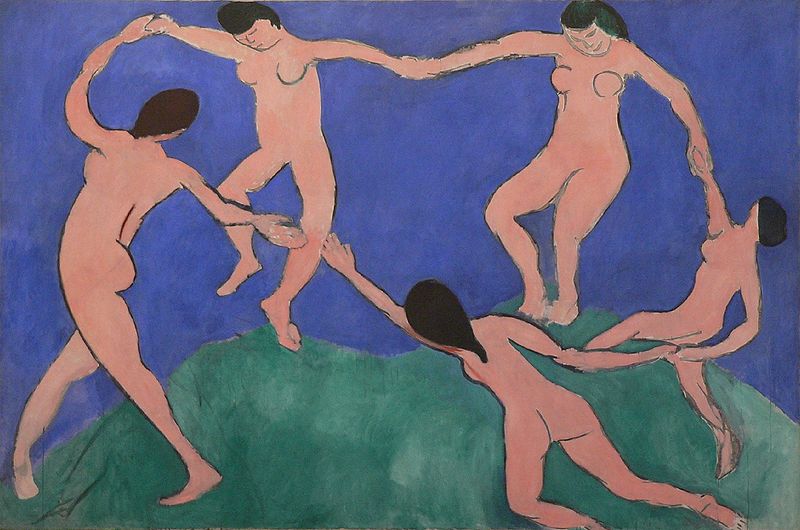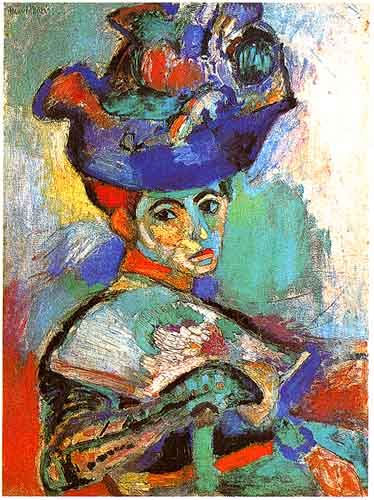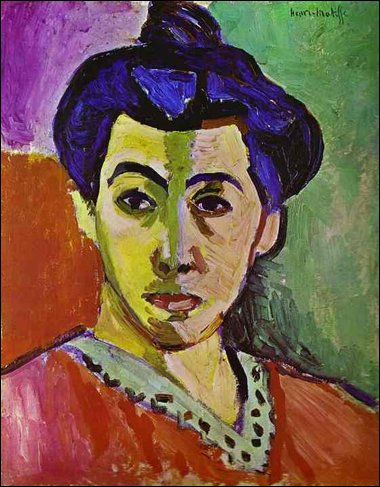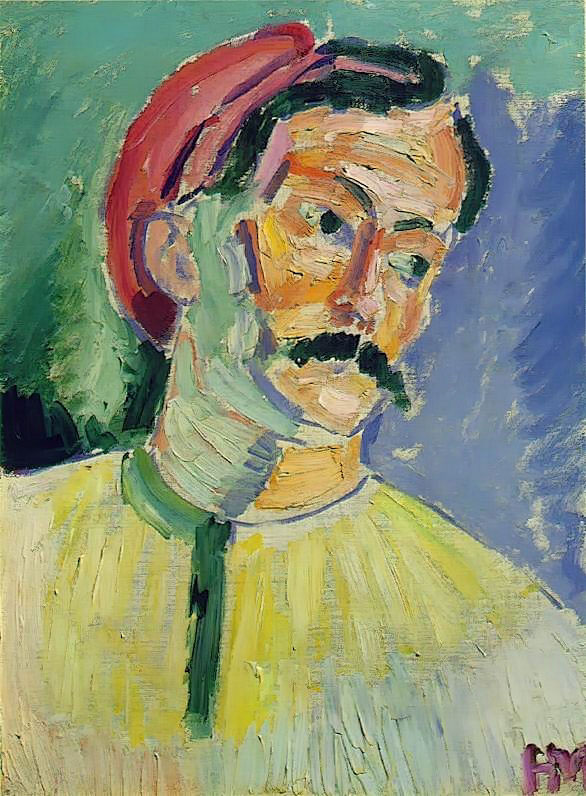Henri Matisse was termed a “wild beast”, a fauve. Traditional art was soon to become an irrelevancy, an anachronism, as experimental art began to develop its own audience, its own markets, and its own rationales apart from being merely anti-traditionalist. It seemed to have began, one summer in 1905, when Matisse, at the suggestion of Pablo Picasso, took his family to the seashore at Collioure. There, in the light of the Mediterranean, a new way of painting came forth. Fauvism lasted only four or five years before most of the artists finally broke with the figurative tradition in painting and embraced cubism. But those brief heady years produced wonderful works of art.
“In the early 1900s, however, the avant-garde was real enough; so indeed were the financial hardships inflicted on its members. The first unmistakable avant-garde event of the new century was the exhibition of an extraordinary roomful of pictures at the Salon
d’Automne of 1905. According to a still not absolutely verified story, the critic Louis Vauxcelles gazed about the room in horror and, seeing in the center a work of sculpture in Renaissance tradition, exclaimed, “Donatello au milieu des fauves!” (“Donatello among the wild beasts!”). The name Fauves immediately stuck to the new movement. “

What Matisse discovered from Cezanne was “Simply that colours in a painting must have a structure, or, to phrase it in another way, that structure is given to a painting by the considered relationship of its constituent colours. That may seem to differ in no way from Seurat’s ideal of structural harmony, but Matisse condemned Seurat for destroying colors integrity by an seemingly mechanical separation.
There is certainly nothing very scientific or even natural about the term “Fauvism”, but it has come to be loaded with a burden of meaning through its association with a set of French painters in the first decade of the twentieth Century. It is the first of the century’s artistic movements and one of its most important. It earns this status through the number of high quality paintings it produced and,
second, to the degree to which these paintings influenced other painters in other places, painters who would themselves take that influence and go somewhere else entirely different. However, the movement was extraordinarily short lived and it never had the internal cohesion of the Impressionist or Nabis associations. It was more like the collision of a set of similarly minded individuals who, upon impact, ricocheted off into other trajectories.

Mme Matisse wear a large fashionable bonnet that had a special meaning for both painter and sitter: Mme matisse supplemented the family income in hard times by moonlighting as a milliner. At a distance of over a century, we can distinguish between the ostentatious finery of Mme Matisse's costume and the sensitive and vulnerable quality of the face that looks out at us.
Although Matisse and André Derain complemented one another, it turned out during their time in Collioure that their respective roles were reversible rather than fixed once and for all. Sometimes it was Derain who felt anxious and uncertain, only to be lifted back onto the rails by Matisse; when Matisse was in crisis, Derain showed unexpected reserves of quiet and logical reasoning. And in the evenings, when Derain settled in for a long, serious talk about painting, Matisse surprised him by his capacity for abstract speculation. Altogether, theirs was one of those marriages of minds that have been so valuable to the art of the twentieth century.
Nature came halfway to meet Matisse and Derain that summer at Collioure; but someone had to see that landscape for the first time as it really is and to go on from there to re-create it with a heightened palette. That is what Matisse and Derain did. When they painted a row of tree trunks, they did not make them a uniform and cautious brown. They made them scarlet, purple, dark green, violet, maroon, ultramarine, yellow-green. The earth was orange, blue, pale green, ocher. The trees had lavender leaves, vermilion leaves, leaves the color of a fresh green almond. The colors did not really merge, but bounced off one another with a cumulative ef
that is irresistibly festive. These must be some of the happiest pictures ever painted.
Matisse: the Green Stripe. In 1905, this whole idea seemed outlandish and unacceptable. People would not believe that the nose could cast a green shadow on cheeks streaked with pink and red. The colors of Collioure, from Naples yellow to bright orange and from vermilion to violet, were all there in this portrait. And Matisse got them to live together in ways which now seem to us perfectly and completely resolved.
They were, not, by the way, what people call “orgies of color.” Everything in them held together. matisse never chose his colors at random; when he showed one of his paintings to the aged Renoir, Renoir looked at it long and hard and said afterward, “I thought he just waved he brush about, but not at all! He couldn’t have taken more trouble.”
Landscape and still life were one thing, the human face quite another. People will accept the reinvention of trees, and yet cry out at the reinvention of the human form. Something of atavistic fear is added to the element of aesthetic exasperation when faces are tampered with. Yet nothing of the sort deterred Matisse or Derain when they painted each other at Collioure in 1905, and the two little paintings now seem to be vivid and penetrating portraits , as do the two portraits of Mme Matisse that Matisse painted in what might be called the “Collioure style” when they got back to Paris.
Matisse and Derain were never again so close as in that summer of 1905. But then again, Matisse did not stick long to the headlong exhilaration of pure Fauve painting. Fauvism was for him a necessary moment, not a lifelong vacation. But he kept on going to Collioure until the fateful summer of 1914, after which he settled permanently in Nice.

Although painted at Collioure, Le Luxe I, is a dream world inhabited by self-absorbed, untroubled goddesses. The shoreline and the hills behind them echo their simplified, rounded forms; all is calm and harmonious.
ADDENDUM:
Despite his awareness of the 19thcentury avantgarde, Derain was heading for a new world without links to the century-old tradition of European art. In one of his last masterpieces, “Effects of Sunlight on Water,” dark blue masses, intended as clouds, stand out against a sky veering from intense red to yellowish ochre. An ill-defined green haze rises from the edge of a narrow blue strip that purports to depict a brook and its vegetation. In a letter to the Fauve painter Maurice de Vlaminck, Derain wrote that “Turner authorized us to create forms beyond real, conventional objects.” The influence of Turner is not in doubt, nor the abyss that separates the elaborate harmony of his most abstract works from the stridency of Derain’s Fauve art.
Having gone thus far, Derain then retreated into mediocre figural painting often bordering on kitsch. It was as if he and other Fauves – de Vlaminck, Van Dongen – had become spent forces with nothing more to say. Within a generation, Western painting as a whole would in turn begin to go down the path of disintegration.
It seems that for many Fauves, their light burned brightly for only a few furious years. Both articles convey the impression that the former Fauvists were left on the outside looking in at the later developments in art. Barnes goes on to mention in his essay how Friesz, Derain, Van Dongen and de Vlaminck were suborned by the Nazis during the occupation and were later excoriated for being collaborationists; perhaps their complicity was due in part to a desire to return to their days of artistic glory almost a half century earlier. A chance to wear once again the laurels of youth.
H. Harvard Arnason: “The fauve revolt was the first violent explosion of twentieth-century art. It established a precedent for the whole series of revolutions that have characterized the history of art since the beginning of the century. Yet it was a curious phenomenon, different in essence from such movements as cubism, abstraction, surrealism. Fauvism as a movement lasted only for a very few years. Although artists associated with the movement were creating what could be described as fauve paintings as early as 1903, the movement as such took shape in 1905 or 1906. Within two or three years members of the group were beginning to explore other directions, and by 1908 fauvism as a movement had ceased to exist. The fauves were not actually introducing a new concept into twentieth-century painting. Rather, they were carrying to their logical conclusions- and in the process, destroying – the concepts of great innovators of the previous generation.”
read more:






 COMMENTS
COMMENTS